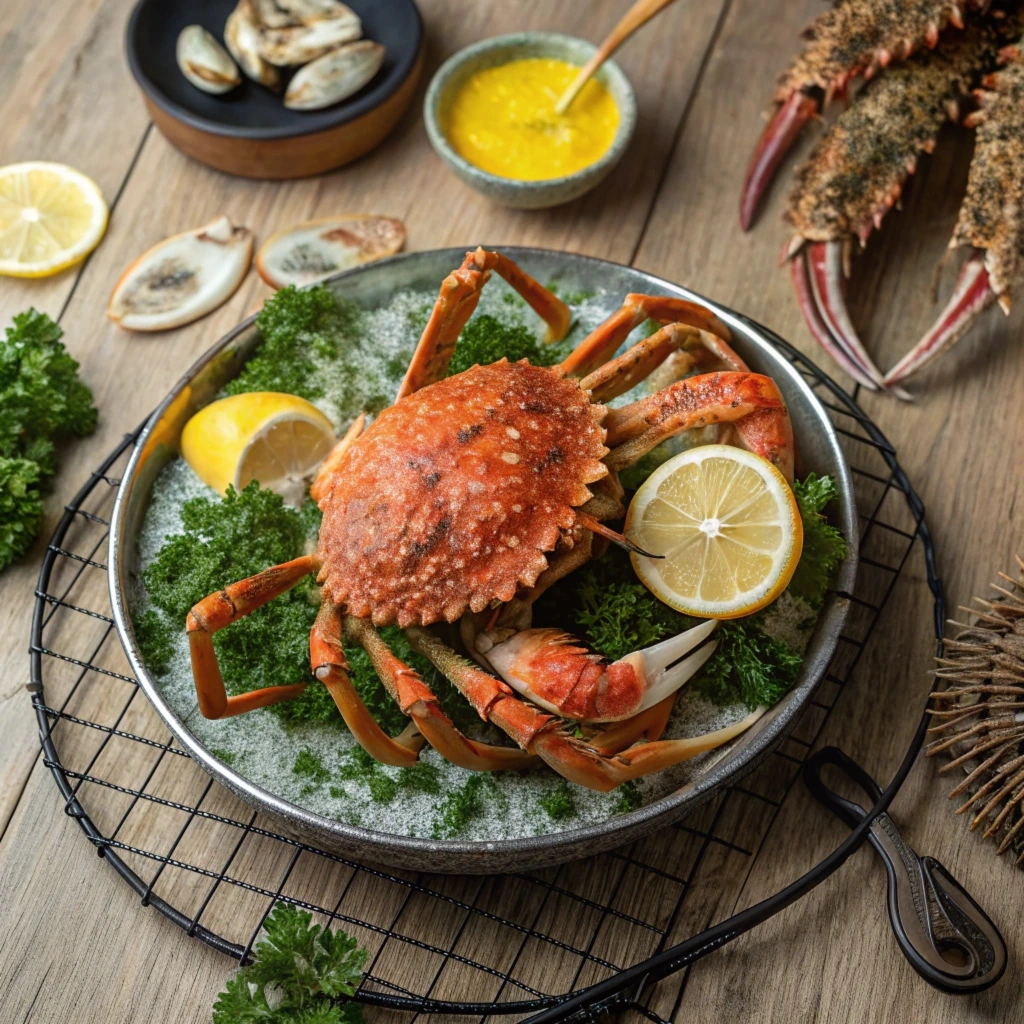Introduction to Spider Crab
What Are Spider Crabs?
Spider crabs are often overlooked in the world of seafood, leaving many people asking, is spider crab good for eating? Despite their tough shells and unique appearance, spider crabs are not only edible but also a true culinary delight. In this article, we’ll explore whether spider crab is good for eating by diving into its taste, nutritional value, recipes, and its growing popularity in global cuisine.
Why the Question: Are They Edible?
It’s a common misconception that spider crabs are inedible. Why? Mostly because they’re not as pretty as their cousins, like king crabs or snow crabs. People mistakenly assume their meat is subpar or even toxic. But here’s the truth: spider crabs are completely safe to eat and have a delicate, sweet flavor that rivals some of the best seafood.
This skepticism stems from their unconventional looks and effort required to crack their shells, making people wonder, is spider crab good for eating?. But those who give spider crabs a try often become fans for life.
Spider Crab Popularity Around the World
Spider crabs enjoy varying degrees of popularity across the globe. In Europe, they’re a delicacy, especially in countries like Spain and France, where they’re often featured in soups and stews. In Japan, the Japanese spider crab, famous for its giant size, is a prized treat in seafood markets. Meanwhile, in parts of the U.S., particularly on the East Coast and California, spider crabs are a well-kept secret among seafood enthusiasts.
Their appeal is growing as adventurous eaters look for new and exciting flavors in their culinary journeys. So, while spider crabs may not yet have universal acclaim, their star is undoubtedly rising.
Nutritional Value and Benefits of Eating Spider Crab.
Nutritional Composition
When it comes to seafood, spider crabs pack a punch in the nutrition department. They’re low in fat and calories, making them an excellent choice for health-conscious eaters. A serving of spider crab is rich in high-quality protein, which helps repair muscles and keeps you full longer. Additionally, it’s loaded with essential vitamins like B12, which supports energy production, and minerals like zinc and magnesium that boost overall wellness.
Spider crabs also offer a good dose of omega-3 fatty acids, known for improving heart health, reducing inflammation, and supporting brain function. These nutrients make spider crab a fantastic addition to any balanced diet.
Health Benefits
If you’re asking, is spider crab good for eating, its health benefits provide a resounding yes.. Thanks to its low calorie count, it’s ideal for those looking to maintain or lose weight while still enjoying flavorful meals. The omega-3s in spider crabs not only promote cardiovascular health but also help reduce the risk of chronic diseases.
On top of that, spider crab meat is a natural source of selenium, a powerful antioxidant that protects your cells from damage and supports your immune system. It’s also a great way to boost your daily intake of iodine, which helps regulate thyroid function.
Comparison with Other Crabs
Compared to popular options like Dungeness crab or blue crab, spider crab holds its own. Its meat is sweet, firm, and equally satisfying. While it might take a little more effort to crack its hard shell, the nutrient-rich and delicious rewards make it worth it.
Catching and Preparing Spider Crabs
How Spider Crabs Are Caught
Spider crabs are typically caught using specialized traps or pots that allow fishermen to harvest them sustainably. These traps are placed on the ocean floor, where spider crabs tend to dwell, waiting to be collected. Unlike faster-moving crabs, spider crabs’ slow and steady nature makes them easier to catch.
In regions like the Atlantic and Pacific, fishing communities rely on spider crabs as a seasonal catch, often during spring or early summer. This practice helps maintain balance in marine ecosystems while providing a steady supply of these crustaceans.
Handling and Storing Spider Crabs
Proper handling and storage are key to keeping spider crabs fresh and tasty. Once caught, they should be kept alive until cooking to ensure the highest quality. If that’s not possible, immediately refrigerate or freeze them. To preserve their flavor, chill cooked spider crabs in ice water before cracking the shells—this keeps the meat from sticking and ensures an easy extraction.
For longer storage, remove the meat from the shell, pat it dry, and vacuum seal it before freezing. This process keeps the meat fresh for weeks without compromising its taste.
Tools and Techniques for Preparing Spider Crab Meat
Cracking spider crabs can be a bit of a workout, but the right tools make all the difference. Unlike the softer shells of Dungeness crab, spider crabs require sturdy crackers or even a small hammer to break through their tough exteriors. A splash guard can help avoid messy surprises when you’re cracking away.
Here’s a trick: break the joints of the legs and pull the meat out in one smooth motion—it’s often easier than smashing the shells. Once extracted, the meat can be used in a wide range of recipes, from soups and curries to simple dishes like crab rolls.
Cooking Spider Crabs: Recipes and Techniques
Basic Cooking Methods
Spider crabs might look intimidating, but preparing them is straightforward. The two most common methods are boiling and steaming, both of which help preserve their naturally sweet flavor. For boiling, immerse the crab in salted water and cook for about 10 minutes per pound. For steaming, use a large pot with a steamer insert and steam the crab for 20 to 30 minutes, depending on its size. Both techniques ensure that the meat remains juicy and flavorful.
A quick tip: After cooking, immediately plunge the crab into ice water to make the meat easier to extract from the shell.
Popular Recipes Featuring Spider Crab
Spider crabs are versatile and work beautifully in various dishes. Here are some popular recipes:
- Crab Spaghetti with Tomato Sauce: A rich Italian classic that pairs the sweetness of spider crab with the tanginess of fresh tomatoes.
- Spider Crab Curry: A flavorful option, especially with large spider crabs, where spices enhance the crab’s delicate taste.
- Crab Risotto: A creamy and indulgent dish that’s perfect for a special dinner.
For more creative ideas, check out the Perfect Crab Brulee Recipe, which offers a unique way to enjoy crab in a deliciously creamy dessert-like dish!
Tips for Enhancing Flavor
Want to elevate your spider crab dishes? Add simple yet flavorful ingredients like lemon, garlic butter, or Old Bay seasoning. These enhance the natural sweetness of the crab meat without overpowering it. Avoid overly complex sauces, as they might mask the delicate flavors of spider crab.
Spider Crab in Culinary Culture
Cultural Significance of Spider Crab Cuisine
Spider crab has been a staple in various cuisines worldwide, celebrated for its unique taste and firm texture. In Europe, it’s a key ingredient in French bisques and Spanish seafood stews. The Japanese spider crab, famous for its size, is served in high-end sushi restaurants as a premium delicacy.
Famous Dishes Featuring Spider Crab
In Spain’s Basque region, spider crab is often prepared as txangurro, a traditional dish where the meat is mixed with breadcrumbs, onions, and tomatoes, then baked in the crab shell. Meanwhile, in California, locals enjoy spider crab in simpler preparations like steamed crab served with melted butter.
Economic Importance of Spider Crabs
Spider crabs are gaining traction in the seafood industry, thanks to their growing popularity among food enthusiasts. Their unique flavor and texture make them a valuable commodity in regions where sustainable seafood practices are prioritized. By choosing spider crab, consumers can support local fishing communities while enjoying a gourmet experience.
FAQs About Eating Spider Crab
Is It Safe to Eat Spider Crabs?
Yes, spider crabs are completely safe, which answers the question, is spider crab good for eating, with a confident yes! Like other edible crabs, spider crabs do not pose any health risks when properly handled and cooked. However, it’s essential to clean them thoroughly and avoid eating the gills or internal organs, as these parts are not edible. When cooking, ensure the crab is heated to an internal temperature of at least 145°F to kill any harmful bacteria.
What Do Spider Crabs Taste Like?
Spider crabs offer a unique flavor profile that’s both sweet and delicate, making them a favorite among seafood lovers. The meat is slightly firmer than that of a blue crab but just as enjoyable. Their taste is often compared to other premium crabs, like Dungeness, but with a hint of nuttiness that sets them apart.
Can You Freeze Spider Crab Meat?
Yes, you can freeze spider crab meat, but for the best results, it’s recommended to remove the meat from the shell first. Pat it dry and vacuum seal it to preserve its flavor and texture. Properly frozen spider crab meat can last for months and still taste fresh when thawed. Always store cooked crabs in airtight containers to prevent freezer burn.
Environmental Impact and Sustainability.
Fishing Practices and Sustainability
Spider crabs are harvested using traps and pots, which are considered environmentally friendly methods. These techniques minimize bycatch and reduce harm to other marine species. Moreover, spider crabs have healthy populations in most regions, making them a sustainable choice for seafood lovers. Supporting fisheries that prioritize ethical practices helps protect marine ecosystems while providing delicious seafood.
Challenges in Spider Crab Harvesting
Despite their abundance, harvesting spider crabs comes with its own set of challenges. Their hard shells require specialized tools, and their slow movement can make them vulnerable to overfishing in certain areas. Additionally, changes in ocean temperatures and habitat loss can impact spider crab populations over time. By choosing sustainably caught crabs and supporting responsible fisheries, consumers can help ensure these fascinating crustaceans remain plentiful for future generations.
Conclusion: Should You Try Spider Crab?
Recap of Benefits and Drawbacks
The answer to is spider crab good for eating is clear. The answer to is spider crab good for eating is clear—spider crabs are a hidden gem in the world of seafood.. offering a sweet, delicate flavor and a wealth of nutritional benefits. Their meat is rich in protein, omega-3 fatty acids, and essential vitamins, making them a healthy addition to your diet. While their tough shells and unique appearance might deter some, these challenges are small compared to the rewards of enjoying their tasty meat.
The effort required to prepare spider crabs is worth it for the culinary experience they provide. With sustainable fishing practices in place, you can enjoy spider crabs guilt-free, knowing you’re supporting ethical seafood choices.
Encouragement to Explore Spider Crab Cuisine
If you’ve never tried spider crab before, now is the perfect time to give it a shot. From simple steaming to elaborate recipes like crab risotto or curries, there are countless ways to enjoy this delicacy. Don’t let its tough exterior fool you—spider crab is a true treasure waiting to be savored.
Final Thoughts and Further Exploration
Expanding Your Culinary Horizons
Spider crabs aren’t just another seafood option—they’re a chance to broaden your culinary palette. Whether you’re a fan of exotic seafood dishes or simply looking for a new twist on traditional crab recipes, spider crabs offer endless possibilities. Their unique flavor and texture make them a standout choice for adventurous foodies.
Where to Start Your Spider Crab Journey
Curious about trying spider crab but not sure where to begin? Start with simple recipes like steaming or boiling, paired with lemon and melted butter. For inspiration, consider exploring recipes like crab spaghetti or crab brulee for a creative twist. You can find great ideas on sites like Perfect Crab Brulee Recipe to take your cooking to the next level.
With the right preparation and a bit of curiosity, spider crabs might just become your new seafood favorite. Dive in and discover what makes these crustaceans so special!

